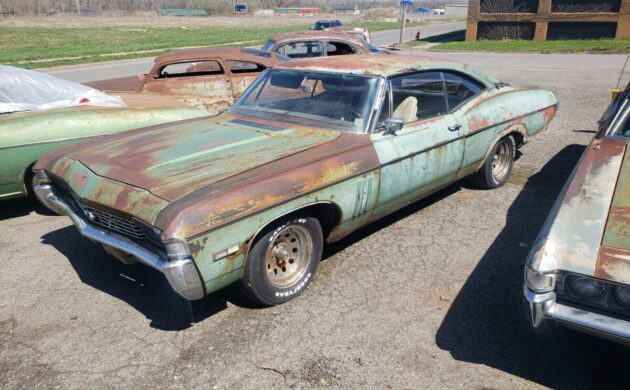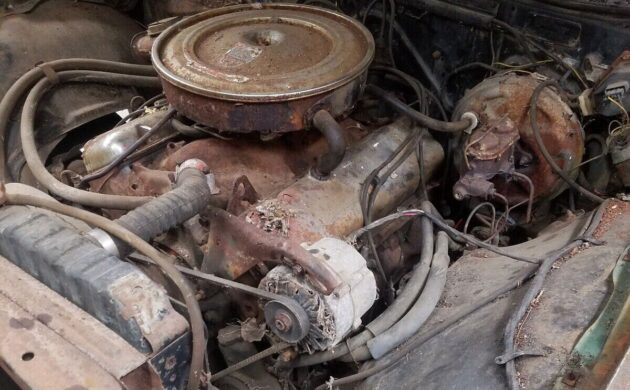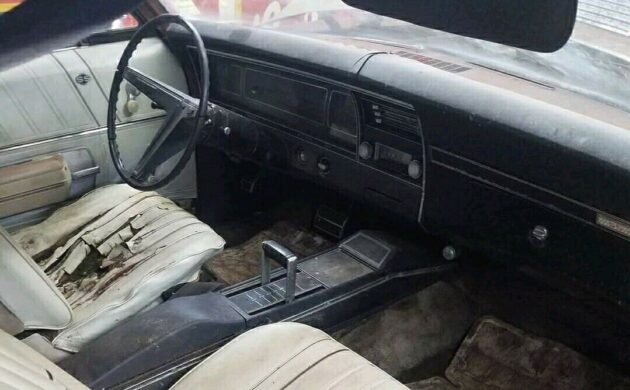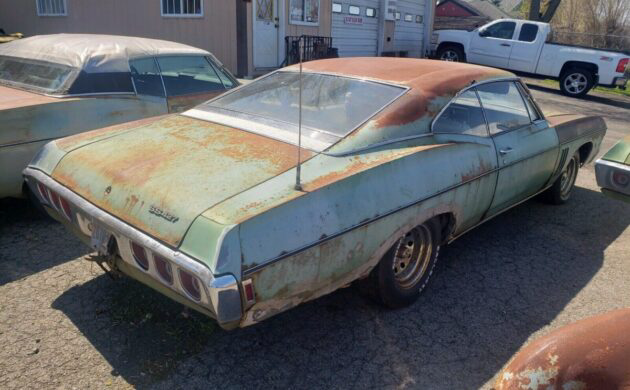We’ve recently seen a few promising Fourth Generation Impalas crossing our desks at Barn Finds, but this 1968 model is something special. It is claimed to be a genuine SS 427 that the original owner parked in a barn in the 1980s. After four decades in hiding, it has been liberated by the seller so that it can find a new home. Its restoration represents a significant undertaking, but a low build total could justify the effort and expense. It is listed for sale here on eBay in Utica, New York. Bidding has crawled to $2,712, which is below the reserve. The seller also offers a BIN option of $18,500.
The seller purchased the Impala from its original owner approximately one year ago, and it remains as they found it. It needs plenty of TLC, with its Grecian Green paint badly faded and evidence of Bondo in both lower rear quarter panels. There may be a couple of rust spots appearing in the lower door corners, but the exterior shows promise. The listing reveals no information on the state of the floors, trunk pan, or frame. There is evidence of plenty of surface corrosion, but it is the dry type that doesn’t appear in a hurry to transform into penetrating rust. However, climbing under this SS to have a good look would be a wise move. Most of the trim and chrome is intact, although several small pieces sport damage beyond repair. The windshield is cloudy around the outer edges, but the remaining glass is fine for a survivor-grade car.
Before we delve too deeply into this Impala’s drivetrain, it is worth noting that it isn’t 100% numbers-matching. The seller indicates that its engine is a “Counter Exchange” unit that Chevrolet probably replaced under warranty. It is the desirable 427ci V8 that would have produced 385hp in its prime. The power was fed to the original 12-bolt rear end via a numbers-matching Turbo Hydramatic transmission. At 4,184lbs, the Impala is significantly heavier than its similarly-powered siblings. However, the ability to scorch through the ¼ mile in 15.4 seconds was considered impressive for a full-sized classic capable of seating five people in comfort. The bad news for potential buyers is that the big-block is locked. The listing suggests the seller has not attempted to free it, which could represent a “chicken or the egg” situation. Four decades of sitting may have caused the engine to lock, although the original owner may have parked the car due to a significant mechanical failure. The truth will be revealed once everything is dismantled, but committing funds, in this case, will require a leap of faith.
In its heyday, this Impala’s interior would have turned heads. Everything from its White vinyl upholstery to its bucket seats and console oozed luxury, but those days are long behind it. As a starting point, it doesn’t appear that anything is missing. However, it will require nothing less than a total restoration for the car to recapture its glory days. The process is unlikely to leave much change from $2,500. That’s a fair chunk of cash, but installed correctly and treated with respect, the new interior trim and upholstery should still present well for decades to come.
By 1968, sales of the Impala SS had fallen off a cliff. There are several reasons why this occurred, but the availability of a big-block option in the Chevelle and Nova probably had the most significant impact. The figures didn’t lie, falling an incredible 80% since 1965. Only 38,210 buyers ticked the SS option on their Order Form, with a mere 1,778 going the extra yard to equip their new purchase with the 427ci big-block. Today, a pristine car will sell for $50,000 in the current market, although higher figures are possible. Values continue climbing, but not rapidly. Returning this Impala to its former glory will take dedication, but are you up for the challenge?






It’s a shame this SS427 ended up with NY FARM plates and forgotten about. That engine if you take a hose and Gunk to it. It may disappear from all that rust on it! 😂 He looking for 18,500 for it!! Good luck!! Worth 6,000 and I am being nice about it. I just hope the next owner doesn’t use it as a parts car for another project. This need to be clean up and driven.. 🐻🇺🇸
A real SS427 car, with all the unique parts, trim and emblems all there. It would cost a fortune to restore it, but it would be an awesome car. When was the last time you saw one?
Looks like there are a couple parts cars nearby. Same color, too.
Price of current bid is fair representation of actual value of this car. Too
easy to get a much better car for BIN price asked for on this one.
$18K for this one is reaching for the moon, seller needs to rethink
asking price!! Considering the condition of this one, I would look elseware before paying $18K.
It’s now at 5,500. They’ll start paying. There is no way this goes for 5,500 in this climate. Close to the bin if not more.
It is incorrect to use the name “Impala”, since it does not appear anywhere on this car. Chevrolet refers to it as the 1968 SS427 in literature.
BTW – It appears that the car was delivered with Factory A/C, though little evidence of it remains.
RC Graham,
You are correct, it’s NOT an Impala. Even the dash panel says SS 427.
However this car has never had factory A/C.
With respect, Mr. McCoskey, my family and I have had many 1968 GM cars. Unless I am badly mistaken, I seem to remember that the Climate Control panel for cars with A/C had 3 knob-sliders, while the non-A/C equipped cars had 2. If I am incorrect, I stand corrected. (I did write “appears”). Admittedly, few of ours have not had A/C.
RC, While you are mostly correct, the ’68 full-size Chevy controls are different. I also took a double take at first, but remembered that these cars with A/C DID have 3 rows of levers, PLUS they also had a vertical fan switch off to the left of the 3 horizontal levers.
Another thing to watch for: It’s got vent windows so that means it didn’t have the flow-thru ventilation, with air vents at either edge of the dash. No air vents on this dash means no A/C.
As for the engine compartment, while the compressor, mounting brackets, hoses and condenser in front of the radiator could have been removed, the big thing to watch out for is the huge HVAC unit built into the dash. When removed, the HVAC unit leaves a hole far larger than the heater core case. This car only shows the heater core assembly in place.
My restoration shop was in the mid-Atlantic area where it does get hot/wet, but only for a couple of months each year. Many 1950s thru 70s cars in our area were not sold with A/C, but by the 1990s we had more than a few customers ask us to install factory A/C units when restoring their cars. I guess now that they had A/C in their homes and modern vehicles, they HAD to have A/C in their vintage cars too!
Some like the early Mustangs or Falcons are easy, GM cars, from Camaros to Impalas are a lot harder to change over due to the A/C unit built into a different firewall assembly, which means for many of them, you have to cut out the right side of the vertical firewall panel & weld in the A/C panel before adding the A/C parts.
Thank you, Bill. As always, it is a pleasure to read such knowledgeable responses from you.
’68s with factory A/C would have had a center HVAC vent hump at the front center of the dash pad … this example does not.
It’s now at 5,500. They’ll start paying. There is no way this goes for 5,500 in this climate. Close to the bin if not more.
$11,100 with over 3 days to go. Don’t stop now boys!!
Hmmmm… I’m thinking the barn this was stored in did not have a roof.
What a shame, just too many decades have gone by. To restore this in 1985 costs and parts availability as well as a human body in 1980s condition: i’m all in!
2022, nope…….
The factory engine was replaced probably because it was blown up drag racing now the replacement is seized from sitting or ? This is a great find but the cost of restoring it would be astronomical compared to finding one done so if bought at a good price and the engine broke free to drive as it would be a great toy.